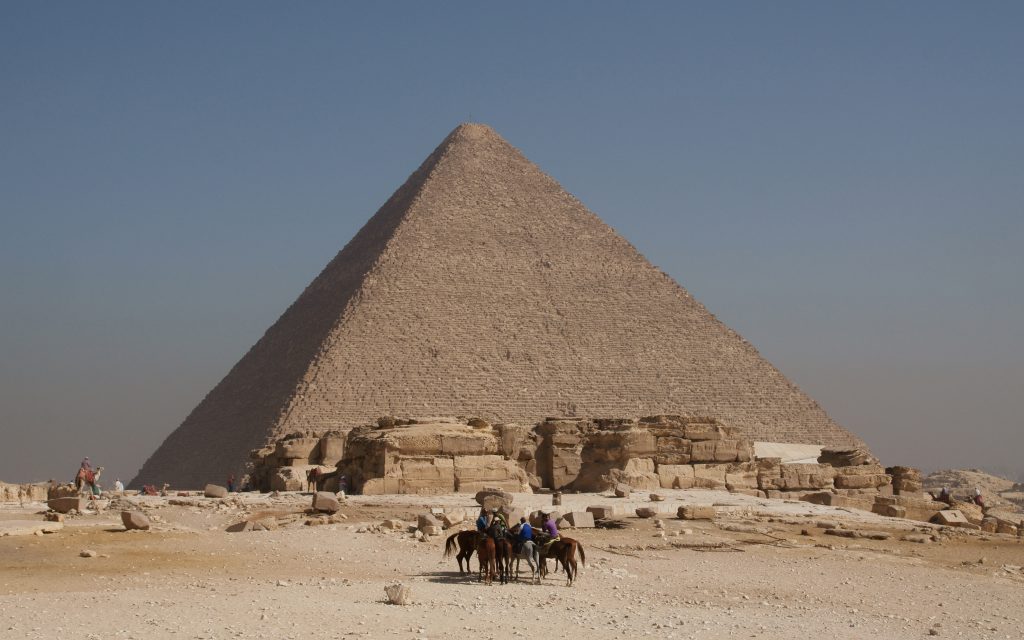The construction of the Great Pyramid of Giza has been a great mystery for many centuries. Recently, archaeologists believe that they have found evidence that suggests that it was not slaves, under the order of King Khufu, who were responsible for building the pyramid. With the discovery of nearby mastabas, there is now substantial evidence suggesting that normal villagers would periodically help construct the Great Pyramid, and they were motivated by their religious beliefs.1
King Khufu is considered one of the greatest rulers of his time, largely due to the elaborate pyramid he was able to create during his lifetime. He was known as a cruel and tyrannical leader, but was evidently powerful by being able to gather a large workforce and enough materials to construct the Great Pyramid, most of which is still intact today. According to Greek historian Herodotus, there had been around one hundred thousand slaves working through King Khufu’s reign. This was proved false in 1990 when the archaeologist Zahi Hawass discovered a town of mastabas near Giza.

These mastabas were rectangular mounds made of mud bricks. Eventually, they would stack some of them together to form pyramids, giving them the idea of the modern pyramid. The findings of many mastabas suggests that the workers were not slaves but were actually compensated in some form for their labor. They also discovered two miniature pyramids that held the remains of officials, such as supervisors, technicians, and craftsmen on the upper level, and other laborers on the lower level.2 The workforce consisted mainly of peasant farmers who would work during the fall and winter seasons. During that time period they were unable to work on their farms due to the seasonal overflow of the Nile River. This gave them an opportunity to continue working throughout the year. It was also a great way for the peasant farmers to get food, clothing, and shelter.3 Some laborers took part in a group called a phyle, which was a rotating group of workers who would work for a month. The king would collect surplus crops as well as other clothing to distribute to these workers, which he levied as a form of tax. Egyptologist such as Zahi Hawass and Mark Lehner now estimate that only about twenty to thirty thousand men were needed to build the Great Pyramid.
The construction of the pyramid was a communal project in which all Egyptians took part, including women as well as men. At the time, there were no machines or animals to help carry the loads of limestone and granite to the pyramids.4 Every block was handmade and crafted to fit perfectly alongside the other pieces. They cared greatly in their work and took pride in their accomplishments. Not only were they building the burial site for their king, but they were also taking part in the construction of a new and elaborate Egypt.
During Egypt’s Old Kingdom, when these pyramids were built, the kings were associated religiously to gods. They were seen as the living manifestation of the god Horus, the god of the sky. The god Horus was also the son of Osiris, who was the king of the underworld. Once the king would pass away he would become one with Horus.5 This helped motivate the laborers to continue building the pyramids. Most Egyptians at that time were very religious and spent their life preparing for what would come after death. They believed that by building the pyramid for their king, a descendant of Osiris, they would assure both their king and themselves a good afterlife. Because of this, they did not see their work as a continuous strain, but rather viewed it as an honor.
Overall, it was a very organized and coherent system that allowed everyone to partake in. It was beneficial not only to King Khufu, but to the entire Egyptian society as well. Jobs were created and many peasants received benefits of clothing and shelter from the enterprise. It united the Egyptian civilization and created magnificent pyramids that we can still visit today.
- Mastabas are burial mounds that were used to bury rulers and pharaohs, which later gave way to the idea of a pyramid. See Global Events : Milestone Events throughout History, Vol 1. Africa, Jennifer Stock, ed. (Detroit : Gale, Cengage Learning, 2014., 2014), 12. ↵
- Global Events : Milestone Events throughout History, Vol 1. Africa, Jennifer Stock, ed. (Detroit : Gale, Cengage Learning, 2014., 2014), 18. ↵
- The Oxford Companion to Archaeology (2 ed.), 2012, s.v. “Pyramids of Giza,” by Edward Bleiberg. ↵
- The Oxford Companion to Archaeology (2 ed.), 2012, s.v. “Pyramids of Giza,” by Edward Bleiberg. ↵
- Funk & Wagnalls New World Encyclopedia, 2016, s.v. “Horus”. ↵



87 comments
Samuel Sanchez
This was a well-written article. I always thought that the pyramids were built by slaves and we see a lot of misconceptions in some movies about the pyramids. I did not know that farmers were the ones working on them. It make sense since farmers have certain seasons that they could work. It’s amazing how the ruler was able to control such a complex system in order to build the pyramid throughout his life. Amazing article.
Nahim Rancharan
This was a very well-written article! It was interesting to see how the history of one of the original seven wonders of the world has been fabricated and misjudged for so many years. The article is well supported by research and data proving a completely different story than what many people still believe to be true. The fact that villagers instead of slaves built the Great Pyramid of Giza was very surprising. In addition to this, the fact that one ruler had been able to orchestrate a system so complex and efficient throughout his lifetime that it has been able to produce a structure so unique that it raises questions even up to this day is quite amazing. This article helps to highlight the truth of one of the world’s greatest creationa. Great Job!
Mario Sosa
I was always under the impression that slaves were the ones to manually build the pyramids, but I never considered that regular citizens were willingly wanting to construct the pyramids. It is incredible that such a gigantic structure was built by people who for the most part only wanted to honor the gods. Also intriguing was how even peasants got clothes and shelter for helping out. Great job on the article!
Elizabeth Garibay
This was an amazing discovery. It’s very interesting to see that the construction of the Great Pyramid was a communal project . I did not know that it was assumed that slaves had built the pyramid that in fact it was actually compensated workers. Before reading this I would’ve never thought they actually gained and benefited from building the pyramid. I love learning new things and this was very interesting. It was a great article, very informal!
Aaron Jaramillo
Very well written article! I’ve always wondered who made these pyramids and of course when I asked I always got the answer the alines did it. Now knowing the common people did it, it makes it 100 times more impressive. Good job.
Christopher Repka
Very interesting that archaeologists believe the pyramids may have been constructed without the use of slave labor! This would be quite an impressive achievement, particularly for the time during which the pyramids were constructed. I wonder if the labor system may have been a tributary system, rather than strict slavery, like that of Mayan Civilizations. I believe their tributary system was also motivated by religious beliefs. I wonder also if the religious obligation was defined by class structure with some sort of religious caste system. Anyways, this article left me with many questions and curiosities I would like to research. Thanks for the interesting article!
Andres Palacios
This article shows the capacity that us humans have to create and develop such amazing things as the pyramids. They were able to create a structure that it is thousands of years old and still standing today. It was great also to learn about the mastabas since I didn’t know anything about them before reading the article. Great job, and excellent topic to write about.
Tina Valdez
This is quite a discovery. It makes sense that the pyramid would have been built by normal villagers considering what you described in your article; the religious significance and compensation for their work. It is really interesting to see the construction of the Great Pyramid as a communal project rather than a salve driven project. This perspective really adds to my understanding of the purpose behind the construction of the pyramids. Great article, very insightful!
Alyssa Almaguer
Great article! This clarified things I thought were true about the construction of the pyramids. I thought slaves constructed it, I had no idea it was the common people! Very informative, great job!
Rafael Ortiz Salas
I found this article very interesting. I think the name Khufu is a pretty funny name. I like the idea that aliens played some part of the building the pyramids. Its amazing the time they took to build the pyramid, everyday working for a couple years is insane. Good article Diana. 🙂